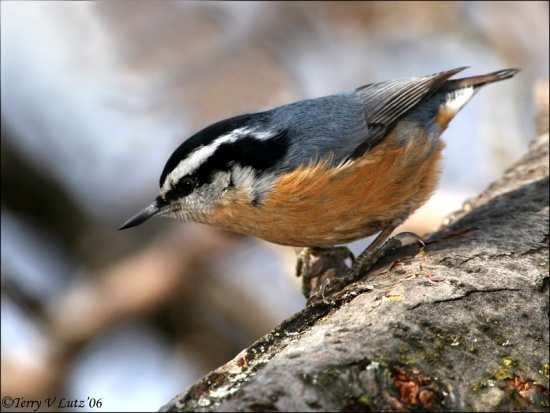m |
m (photo caption) |
||
| Line 1: | Line 1: | ||
| − | [[Image:Red-breasted_Nuthatch.jpg|thumb|550px|right|Photo by etow<br/> | + | [[Image:Red-breasted_Nuthatch.jpg|thumb|550px|right|Photo by {{user|etow|etow}}<br/>North Central Ohio, USA, February 2006]] |
| + | '''Alternative name: Red-bellied Nuthatch''' | ||
;[[:Category:Sitta|Sitta]] canadensis | ;[[:Category:Sitta|Sitta]] canadensis | ||
==Identification== | ==Identification== | ||
| Line 12: | Line 13: | ||
*Black upper mandible, pale grey lower | *Black upper mandible, pale grey lower | ||
*dusky legs and feet | *dusky legs and feet | ||
| − | |||
====Females==== | ====Females==== | ||
*Similar to males, but the crown and nape are dark grey, not black | *Similar to males, but the crown and nape are dark grey, not black | ||
*Eyestripe is variable but usually paler than in males | *Eyestripe is variable but usually paler than in males | ||
*Underparts are paler, not as richly coloured as males | *Underparts are paler, not as richly coloured as males | ||
| − | |||
==Distribution== | ==Distribution== | ||
| − | Breeds across [[Canada]] and [[United States]]. | + | Breeds across [[Canada]] and [[United States]].<br /> |
| + | Fairly common to abundant. | ||
==Taxonomy== | ==Taxonomy== | ||
| − | + | This is a [[Dictionary_M-S#M|monotypic]] species. | |
==Habitat== | ==Habitat== | ||
Coniferous forests; more widespread during migration and winter. | Coniferous forests; more widespread during migration and winter. | ||
| − | |||
==Behaviour== | ==Behaviour== | ||
====Diet==== | ====Diet==== | ||
Nuthatches hoard excess food and will transport seed from a tree heavily laden with mature cones to their distant larders. They also feed on bark insects. | Nuthatches hoard excess food and will transport seed from a tree heavily laden with mature cones to their distant larders. They also feed on bark insects. | ||
| − | + | ====Vocalisation==== | |
| − | == | ||
A tinny ''yank-yank'', higher pitched and more nasal than the call of the [[White-breasted Nuthatch]]. Some describe it as sounding similar to a toy tin horn. | A tinny ''yank-yank'', higher pitched and more nasal than the call of the [[White-breasted Nuthatch]]. Some describe it as sounding similar to a toy tin horn. | ||
| − | + | ==References== | |
| + | #{{Ref-Clements6thAug11}} | ||
| + | {{ref}} | ||
==External Links== | ==External Links== | ||
{{GSearch|Sitta+canadensis}} | {{GSearch|Sitta+canadensis}} | ||
[[Category:Birds]] [[Category:Sitta]] | [[Category:Birds]] [[Category:Sitta]] | ||
Revision as of 18:48, 5 July 2012
Alternative name: Red-bellied Nuthatch
- Sitta canadensis
Identification
- Black crown and nape
- White lores, the supercilium, and the sides of the mantle
- Black eyestripe broadens backward to the sides of the mantle
- White chin, cheeks, ear coverts, and sides of the upper neck
- Grey blue upperparts, lesser and median coverts, and central tail feathers
- Outer 4 tail feathers have white centres; outer 3 have grey-blue tips
- Dark grey brown flight feathers
- Cinnamon lower neck, breast, flanks, belly, vent, and undertail coverts
- Black upper mandible, pale grey lower
- dusky legs and feet
Females
- Similar to males, but the crown and nape are dark grey, not black
- Eyestripe is variable but usually paler than in males
- Underparts are paler, not as richly coloured as males
Distribution
Breeds across Canada and United States.
Fairly common to abundant.
Taxonomy
This is a monotypic species.
Habitat
Coniferous forests; more widespread during migration and winter.
Behaviour
Diet
Nuthatches hoard excess food and will transport seed from a tree heavily laden with mature cones to their distant larders. They also feed on bark insects.
Vocalisation
A tinny yank-yank, higher pitched and more nasal than the call of the White-breasted Nuthatch. Some describe it as sounding similar to a toy tin horn.
References
- Clements, JF. 2011. The Clements Checklist of Birds of the World. 6th ed., with updates to August 2011. Ithaca: Cornell Univ. Press. ISBN 978-0801445019. Spreadsheet available at http://www.birds.cornell.edu/clementschecklist/downloadable-clements-checklist
Recommended Citation
- BirdForum Opus contributors. (2024) Red-breasted Nuthatch. In: BirdForum, the forum for wild birds and birding. Retrieved 14 May 2024 from https://www.birdforum.net/opus/Red-breasted_Nuthatch




